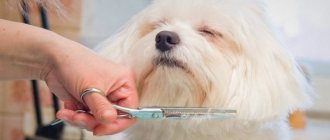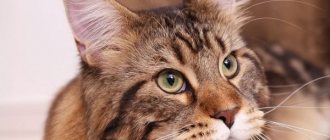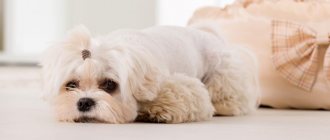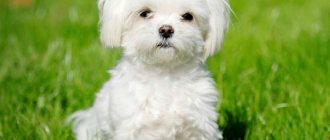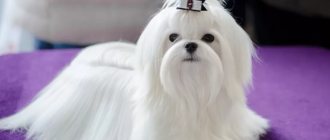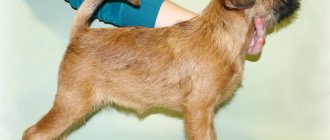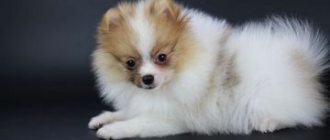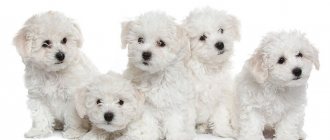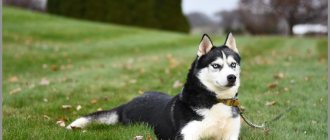Care and maintenance
It is possible for a Maltese to live in both a large house and a small apartment, but the first option is still preferable. This way the pet can have constant contact with its owners. The peculiarity of the Maltese, like other small dogs, is that the animal can be trained to go to the litter box.
To maintain the elegant appearance of a lap dog, owners will have to put a lot of effort at home. Moreover, this requires not only time, but also material costs. Animal care comes down to the following points:
- Combing. The dog practically does not shed, but the coat needs daily combing to maintain a neat appearance.
- Bathing. The animal should be bathed using special shampoos and balms designed for long-haired dogs. Sometimes you can use care products to prevent the formation of tangles.
- A haircut. If the owners do not plan to participate in exhibitions with the dog, they can do a daily haircut. A shorn dog wears short hair, with the length kept to a minimum. Also popular are hygienic haircuts, in which most of the hair is shortened on the genitals. Grooming a dog once for a show is not enough. This procedure must be repeated at least 3 times a year.
There is a summer version of a puppy haircut that improves heat exchange in the summer. This grooming allows owners to spend less time caring for the coat.
Particular attention should be paid to the eyes, where dirt regularly accumulates due to tearing. In this case, the eyes become red and dark tracks appear under them. This can happen for various reasons:
This can happen for various reasons:
- influence of external factors (dust, wind, etc.);
- internal processes in the body (estrus, change of teeth, postpartum period);
- allergy;
- inflammation associated with disease (for example, conjunctivitis).
If your eyes are running, you must first determine the cause that caused this condition. Typically, most are temporary or can be resolved with medication.
When feeding your lapdog, it is important to consider the following points:
- Do not overfeed. Representatives of the breed are prone to obesity, so overeating threatens gastrointestinal, heart and digestive diseases. You can understand that an animal is overeating not only by rapidly gaining weight. At first, the dog’s stomach is churning, as the gastrointestinal tract cannot cope with the volume of food received.
- Do not feed human food. Many foods from the household table, for example, sausages, canned food, sweets, can lead to digestive disorders. Also, such snacks can throw off your eating schedule.
If the owners are going to feed the animal with dry food, the brand should be at least premium. Moreover, the food is intended for miniature dogs.
If the food is natural, then the pet’s menu should include:
- lean meat (boiled beef or chicken);
- kefir;
- cottage cheese;
- porridge (buckwheat or rice);
- apples;
- eggs.
If the food is not suitable for the pet, this can be determined by the condition of the coat. When the coat becomes dull, brittle, or dandruff forms, these are signs of improper feeding.
What to feed a puppy
Puppies can also be kept on natural food or commercial food. There are usually no problems with the latter. Babies can be given dry food starting from 1 month. It can be slightly soaked in water beforehand for better chewing.
When feeding naturally, the puppy's menu should contain:
- porridge with added meat;
- pure meat (beef, rabbit or turkey);
- sea fish without bones;
- vegetables and herbs;
- cottage cheese.
At the age of 2-4 months, babies should eat 4 times a day, at 4-6 months - three times a day. From 8 months, the puppy gradually becomes an adult dog, so feeding should be done twice a day.
Diseases
Unfortunately, this breed has a considerable list of diseases. These cute dogs suffer from diseases of the eyes, teeth, heart, stomach, as well as eclampsia and allergies.
It is important to know the decoding of symptoms in order to properly help your pet.
Symptoms
Urine with blood
An alarming situation is when the lap dog is hiccupping and blood is released in the urine. This indicates possible cystitis or cancer in the dog. Without professional diagnosis and consultation with a doctor, it is impossible to identify the exact cause of these symptoms. Self-medication is strictly prohibited.
What to do when your eyes are running?
Glaucoma is the most common disease in which there is excessive tearing, strabismus, enlargement of the eyeball, blindness, and acute pain. Glaucoma is caused by a violation of the outflow of fluid from the chambers of the eye. The pressure rises, the retina is destroyed, and ischemia of the eye tissue occurs. You should consult your doctor immediately to get the right advice and treatment.
Seething in the stomach
This is an upset stomach. Caused by illiterate feeding, for example, a combination of dry food with natural food. Usually the dog refuses food for several days. But after a meal, stool appears with a large amount of elastic mucus. You should choose one type of food and make your pet drink more boiled water. Medicines are prescribed only by a doctor.
Gases
This is flatulence, which has similar symptoms and causes of appearance with seething in the stomach. However, gases can also be caused by poisoning.
Treatment
Prevention of diseases is the best treatment. The action plan is as follows:
- undergo an oral examination 2 times a year;
- carry out annual sanitation of the Maltese’s oral cavity;
- undergo echocardiographic examination 2 times a year;
- regularly measure intraocular pressure.
If your dog suddenly becomes lethargic, apathetic and refuses to eat, then immediately visit a veterinarian. Only a specialist will determine the exact cause of the ailment, announce the diagnosis and prescribe treatment.
Attention! When walking with Snow White, you need to carefully monitor her behavior. You should not allow the dog to eat from the ground, eat unknown grass, and so on.
Otherwise there is a risk of poisoning.
Grooming Maltese and any other lapdog
The wool of lapdogs is constantly growing and can be very long - up to the floor, and indefinitely. In addition, the Maltese has white fur. All this requires constant care. Have you seen unkempt lap dogs on the city streets? How do these dogs and their owners make you feel?
You can’t imagine how quickly such wool falls off; sometimes the tangles cannot be combed out and you have to cut or shave them off. And under the tangles, the skin gets warm, the wool dries poorly in the tangles and bacteria and parasites grow. I don’t want to scare you, but I want to warn you.
The Maltese is considered a non-clipping breed in grooming. This means that show dogs are not cut, but their long hair and structure are carefully preserved so that it does not get cut. The fur needs to be combed every day. To preserve the Maltese's long coat, it is collected in curlers.
The long, well-groomed, white coat of the Maltese is impressive. It's elegant and graceful. Under its own weight, the hair stops curling and becomes straight and flowing.
In the ring, the Maltese's hair should almost touch the floor.
This image of a dog is suitable for those owners who have time to care for their pet; this often becomes the owner’s hobby.
If the Maltese does not participate in exhibitions, and you have little time to care for it, then it is easier to cut it. A properly trimmed and groomed Maltese is undoubtedly very cute.
Any Maltese dog, whether it is a show dog or just a pet, needs daily, hygienic grooming:
>Cut and sharpen your dog’s claws every 4-6 weeks >Free the paw pads from excess hair, trim long hair around the paw so that it does not interfere with free running and does not collect dirt >You can and should bathe your dog as it gets dirty, using a specialized shampoo for long hair wool and conditioner. >Brush your dog's fur more often, especially after bathing, using a slicker brush and a hair dryer >Wipe the fur in the corners of your dog's eyes and paws as they become dirty. The white coat of the Maltese quickly absorbs dirt and loses its whiteness, turning into brown tracks. >Don't forget to clean your ears, if possible, removing excess hair in the ear canals to improve aeration >It is necessary to monitor the condition of your dog's teeth and brush them on time to prevent the development of tartar
Coton de Tulear
The second name of the breed is Madagascar Bichon. The Bolonki Islands arrived from France in the 17th century.
There is a legend that after a shipwreck near the port of Tulear, several dogs survived and bravely swam across the rest of the strait and ended up on the island, where they mixed with aboriginal mongrels. This is how we got the unyielding, brave, fearless Bichons - Coton do Tulear (the first part of the name translates as “cotton” from French)
Like all Bolonki, Cotons are small (up to 28 cm at the withers), stocky, dense, but graceful and graceful, with long ears, a high tail and a royal posture. Their distinctive feature is long gray or ashy spots among the curls of flowing, wavy white coat. Due to their short, thick limbs, Tulears have to jump with four legs rather than two.
Animals will follow their master into fire and water. They are ideal companions with good physical fitness, hardy, courageous and cheerful. Dogs know how to adapt to their owner: they are ready to entertain children, relax with an elderly person, go for a run in the morning or lie on the couch all day.
The breed is hardened by hot climates and work, so Cotons still exhibit survival instincts to this day. They can strangle a rodent or bark at a stranger
It is important for them to protect the owner and his property.
Dogs are valued for their intelligence, willingness to train and learn. But if training is not started on time, puppies become fearful, withdrawn and uncommunicative. The average cost is 35,000 rubles.
Types of Maltese haircuts
Experts offer several basic options for grooming Maltese dogs:
Exhibition haircut. In this case, the length and quality of the pet’s coat is decisive. Groomers do not shorten the coat, but only give it a well-groomed appearance, trimming the contour and giving the outline of the animal’s body a harmonious appearance. In an ideal show cut, the hair on the head is gathered into top notes (tails) that flow smoothly into a parting along the entire length of the body. Great importance is attached to hygiene procedures performed at the stage of preparing a dog for an exhibition. Cleaning the ears, trimming the hair between the toes, between the pads of the paws, and also in the groin area is included in the mandatory minimum for caring for the dog. In this haircut, the hair between the eyes is not cut.
Maltese puppy haircut (Mouton). It involves the use of scissors to shorten the coat, and the machine is used solely for the purpose of performing hygienic manipulations. After performing the manipulation, the contours of an adult dog resemble a teenager. This is precisely what explains the name of the summer “puppy” haircut. It can also be performed in winter, but you will need to purchase warm clothes to avoid hypothermia and prolonged illness of your pet. In most cases, the specialist leaves the hair on the legs and body the same length, and on the face he only trims the bangs, eyebrows and mustache, making them slightly longer than on the rest of the body.
A hygienic haircut is indispensable for owners who do not accept a puppy haircut, but also do not plan to participate in exhibitions. The coat can be shortened according to the wishes of the breeder, and also dyed in various shades with special dyes. An “intimate haircut” is required, as well as hair removal between the toes and between the paw pads. Veterinarians remind you of the need to remove hair from the inner surface of the ear, as this can lead to inflammatory diseases as a result of the accumulation of wax and the addition of a secondary infection. Nail trimming, oral care and cleaning of the anal glands should also be carried out regularly, which allows you to maintain the animal in impeccable condition.
Best articles: Satellites of Mars: history of discovery, research, characteristics and photos
The Korean Style haircut involves greatly shortened hair on the pet's face and shaved cheeks. Longer strands are left behind the ears and on the back of the head. They can be shaped like a cap or a ponytail. The neck is also cut quite short, but the length of the hair on the body does not have strict restrictions and it all depends on the desire of the owner.
In most cases, the pet's fur grows back quite quickly. Therefore, you will have to visit the salon once every 1-1.5 months to perform hygienic procedures and once every 1.5-3 months to perform a high-quality haircut for your pet. When grooming a puppy, it is enough to shorten the coat once every 3-4 months. But to maintain the impeccable shape of a pet with a show haircut, you need to visit the groomer 2-3 times a month.
What is the difference between cutting a “girl’s” haircut and a “boy’s” haircut?
In order for a dog to look attractive, in addition to professional grooming, it needs daily care, which the owner can provide for it himself. Experienced dog breeders even draw up special schedules in which they indicate on which day the dog has a haircut and on which day it has a bath.
Professional breeders recommend accustoming your dog to grooming procedures from an early age. Both a puppy and an adult lap dog must endure without fear or aggression:
- washing paws after a walk;
- bathing;
- hygienic haircut;
- cleaning ears, eyes and teeth;
- trimming nails;
- winding wool on curlers.
Each owner chooses how to cut a dog's haircut himself. The only thing he should know is that certain requirements are put forward for the appearance of animals that take part in exhibitions. So, the Maltese’s coat should not be 5-10 cm longer than the height of the dog itself at the withers. When moving, it should flow; when the dog is calm, the hair should beautifully frame its silhouette. Lap dogs, which for one reason or another do not take part in exhibitions, can look the way their owners want.
When a dog enters exhibitions, the thoroughness and scrupulousness of the process is very important. Dogs with soft fur are groomed once a month. But everyday haircuts can be done at home. In other cases, contact a groomer - a “dog hairdresser”: he will perform a haircut of any complexity quickly and professionally.
There is a natural difference in trimming hair in the genital area of females and males. The hair on the male's head is cut mostly short, but the female is left with long locks, sometimes braided in the form of braids. But “puppy” haircuts are not suitable for “girls.”
In the area of the genitals and buttocks, the hair is shortened - this will allow the lapdog to avoid inflammation from lack of access to open air. Hair on the belly and in the area of the paw pads is also removed. Substantial hair removal up to the scalp will keep your dog comfortable in hot summer weather.
Exterior
The breed standard of the Fédération Cynologique Internationale (FCI) classifies the Maltese as a group of toy dogs, a subgroup of the Bichon and related breeds. In addition to the Maltese, this also includes Bolognese and Bichon Frize.
Photo of an adult Maltese dog.
Maltese dogs look charming, both in person and in photographs. These are miniature dogs with a snow-white coat that flows down the sides, black beady eyes and a charcoal nose. They have smooth, refined movements and the manners of aristocrats.
The table provides a detailed description of the breed.
| Parameter | Breed standard |
| Height | 21-25 cm males, 20-23 cm females. |
| Weight | 3-4 kg. |
| Constitution | Developed, dry, without roughness. |
| Frame | Stretched out, with a long straight back and a short arched loin. The neck is of moderate length and holds the head elegantly. The chest is voluminous, long, in circumference equal to 2/3 of the dog’s height. The stomach is slightly retracted. |
| Head | The length reaches more than half the height at the withers. Proportional, wide, ovoid, with a convex crown and nape. The forehead is divided in the middle by a hollow. |
| Ears | They stand high, hanging, if the dog is alert, they rise. In the shape of a triangle with round ends. Covered with long hair, which smoothly connects with the fur coat at the withers. |
| Eyes | Large, round in shape, set low and moderately deep. The color is dark brown, the edging is black. |
| Nose | Small, black. |
| Lips | Dry, thin, black mucous. The upper lip hangs over the lower lip. |
| Bite | Scissor-shaped. |
| Limbs | Straight, muscular, parallel when viewed from the rear or front. Stand clearly under the body, elbows pressed to the chest. |
| Paws | Small, collected in a round lump. Richly covered with wool. The pads and claws are strong and black. |
| Tail | Stands at the height of the back, thrown back and pressed to the body on the left or right. Equal to 60% of the dog's height, trimmed with straight, flowing hair. |
| Wool | Straight, long, reaches 22 cm, spreads along the ground. There is no undercoat. A mantle flows down the sides. The hairs on the head are the longest, blending in with the hair on the ears and face. |
| Color | White, less often - ivory. |
Features of keeping a Maltese dog
Potential owners of this beautiful dog need to find out in advance what responsibilities owning a Maltese will entail. The lapdog is very demanding and will feel good only if:
- having your own bed;
- properly selected diet;
- regular grooming with all its constituent elements;
- control and monitoring of health status by a veterinarian;
- mandatory socialization, education and training.
Arranging your personal space
A lap dog bed must be purchased before the puppy gets into the house. The place where it will be located should be quiet and cozy. The “corner” should not be close to the front door. It is also necessary to ensure that the animal sleeping on it does not freeze from a draft or, conversely, does not experience discomfort from excessively high temperatures.
There should be no wires or objects near the bed that the dog might want to try on the tooth. You should not stir the dog's bed near the dog's feeder. The optimal place for it would be a corner in the master bedroom or children's room (for adult children).
Making a menu
Your veterinarian will tell you how to properly create a menu for your Maltese. First of all, it is necessary to understand that the health, activity and appearance of the dog depend on nutrition. The diet must be compiled taking into account the individual characteristics and needs of each representative of the breed separately, without forgetting about the general recommendations.
You shouldn’t be too zealous in trying to feed your lapdog beyond the norm. These dogs are already poor at controlling the amount of food they consume and are often overweight and obese. Putting a dog on a diet is much more difficult than simply feeding it as much as it needs and what you can.
The owner must carefully monitor not only what his pet eats, but also whether he has an appetite. If there are any changes in eating behavior, this is a reason to take the dog for an emergency appointment with the veterinarian.
Grooming and its components
You should not think that grooming is just combing and cutting; it is a set of procedures that includes caring for the eyes, ears, and claws. However, if the owner can clean the ears and eyes himself, cutting and caring for the coat is much more complicated.
In order for the Maltese to have an attractive appearance, the master groomer will have to work hard on this. During skincare procedures, not only scissors and combs are used, but also shampoos, conditioners, hair dryers and other attributes necessary for beauty.
In addition to the fact that a lapdog needs to be cut so that its fur does not get dirty during street walks in bad weather, it also needs clothes
Special overalls, raincoats and raincoats will not only prevent the snow-white creature from getting wet, they will also protect it from hypothermia, which is also very important.
Taking care of your lapdog's health
In order for a lapdog to remain “in service” for as long as possible, it needs to be given as much attention as possible. The owner is required to:
- constantly monitor the condition and behavior of the pet;
- carry out coat inspections;
- take your dog to the veterinarian for examinations and vaccinations;
- Monitor your dog's behavior while walking outside.
The latter is especially important, since a lot of dangers can await a dog while it is on the street. In order to prevent the lapdog from accidentally eating poison, she must be forbidden from early childhood to eat anything outside the home. It’s also worth protecting your sissy from yard dogs, who may not like her
It is also worth protecting the sissy from yard dogs, who may not like her.
Socialization and education will also be useful so that the Maltese is not afraid of sharp sounds and strangers. If a correct and harmonious relationship is built between the dog and the owner, which can only be achieved with the help of proper training, both the person and the dog will enjoy the union.
Breed characteristics
Although the Bolognese's long history began with a career as a rat catcher, it had virtually no influence on the character of these dogs.
Bologneses absolutely cannot stand being alone.
For much longer, the lapdog was a resident of rich mansions and estates, the most beloved animal in noble families, where the owners kept entire kennels of hunting dogs.
As a result, the little pet learned to make friends with numerous pets and truly become attached to its owners.
The most distinctive feature of Bolognese is the absolute inability to be alone. The dog perceives the absence of people as a personal tragedy, loudly protesting against it. The owner of a dog of this breed must constantly be close to his pet, and not leave him alone for more than a couple of hours, otherwise the surrounding area will be filled with sorrowful barking.
The delicate nervous organization of representatives of this breed is the cause of all kinds of somatic diseases. The dog mopes when little attention is paid to him, even if the owner is nearby. But if the Bolognese feels care and love, then he is always in a good mood, loves to entertain his household with various tricks and tricks, which he is a great master at inventing.
The Bolognese is an ideal apartment dog; it does not require much physical activity, but representatives of this breed will happily run around in the park or accompany their owners on a hike. They tolerate heat and cold well, are quite hardy and do not consider themselves gentle creatures at all.
The small size and apparent fragility of the Bolognese does not prevent it from bravely rushing to protect the home or owner if they are in danger. A piercing, loud bark is the main weapon of a guard, and so that the pet does not annoy the family day and night, reacting to the slightest noise, it needs to be taught the rules of good behavior. Bolognese bravely protects his owner and home with his ringing bark.
Bolognese bravely protects his owner and home with his ringing bark.
Subtleties of training
Without timely education and training, a cute, charming Bolognese puppy will grow into a dog with a disgusting character. The dog, considering himself the center of the Universe, attacks household members and people he knows, threatening them with sharp white teeth. To avoid this transformation, the puppy needs to be introduced to street noise as early as possible and taken to crowded places.
Friends who come to the house, neighbors and just passers-by can be asked to communicate with the dog, pet him and treat him. Only with timely socialization will a tiny puppy grow into a charming and friendly adult dog.
The Bolognese is a dog breed that is highly trainable, and the dog is easy to teach not only various commands from the general training course, but also interesting tricks. Dogs of this breed are excellent at training and perform successfully in agility, obedience, and freestyle. The owner, using the dog's strong affection and desire to please, can teach him many household tricks.
A little history
Beauty replaces historical facts about the Maltese dog. Previously, such dogs were at the palaces of royal families, but they were often punished, but their genes have preserved this breed to the present day. The first breeds include fairly large dogs that resemble Great Danes.
It is important to emphasize that the Maltese has always belonged to a valuable breed. At any time, the increase in the number of livestock was constantly under the strictest control.
Best articles: What's in a camel's hump? Water or Fat!
Maltese puppies were sold for huge sums of money and exclusively in a small circle.
The breed was often presented as a souvenir as a sign of respect.
Popular types of haircuts
Giving a dog a fashionable haircut is not easy. Fashion for dog hairstyles is very fleeting and changes almost every season. Now, judging by the feedback from our readers, the following haircuts are popular:
- under a teddy bear;
- in Korean style;
- like a puppy;
- shaving like a chinchilla.
If a fashionable dog look does not seem impressive enough to the owner, then you can add a couple of colored strands or rhinestones to it.
Classic show haircut
To win the show, the dog must meet the breed standard as closely as possible. The length is practically not touched, the fur is slightly stretched and given a well-groomed appearance. The paws should appear round, so excess hair between the toes is removed.
An exhibition is a responsible event; if the owner is not very experienced in hairdressing, then it is better to entrust the preparation to a qualified groomer. A dog that is not cut to standard will most likely be disqualified.
Differences in haircuts for females and males
Dog haircuts, unlike human haircuts, do not have clear divisions into women's and men's. The groomer can offer the same hairstyle to both the dog and the bitch.
There are differences in the technique of cutting the genital area. Boys often have short hairstyles, leaving long hair only on the head. Girls are given a more feminine look and are often decorated with bows or rhinestones.
Varieties of hairstyles - from classic to original
The breed standard specifies that in order to participate in competitions, a Maltese's coat must be 5-10 cm longer than the height at the withers. In this case, the snow-white mantle in a static position forms a clear silhouette. Grooming a lap dog for participation in exhibitions should emphasize the animal's advantages and hide its shortcomings.
There are many other hairstyles for dogs purchased as pets. Fashion here is very diverse, the most popular are:
- like a puppy;
- kawaii;
- under a teddy bear;
- hygienic.
The lush coat allows you to create various original images. The unlimited ability to change appearance is one of the reasons for the great popularity of the Maltese.
Grooming a lap dog at home
You can also care for Maltese fur at home. To do this, you will need to buy high-quality tools, study the rules and techniques of cutting, but the main thing is to hone your skills in practice.
Preparation for the procedure
Before cutting a Maltese, you need to bathe it with shampoo and a special balm for easy combing. Afterwards, the animal needs to be dried with a hairdryer in the direction of hair growth and combed, getting rid of all tangles. At this stage, the dog is completely ready for further grooming.
To fully groom your dog, you will need the following tools:
- combs and slickers for combing wool before and during the procedure;
- well-sharpened hairdressing scissors;
To cut a lap dog, you need to purchase high-quality professional scissors. - clipper (it is better if the tool is specifically for animals, and not for cutting people, otherwise it may simply not cope with the delicate fur of a lapdog);
- nail clipper;
- cotton pads for ears.
Procedure for cutting
The haircut itself should take place in several stages:
- The dog needs to be seated on a surface that is comfortable in height for the groomer.
- It’s better to start with the bangs - move the desired length away from the eyes and cut off the cap.
Maltese haircut starts with bangs - We trim or shave the space between the ears, making sure the result is symmetrical.
Stage two: cutting between the ears - The next stage is cutting the back.
Here you also need to focus on the desired length of the finished hairstyle. If you need to cut your dog’s hair as short as possible, then this result can only be achieved with a clipper against the growth of the hair; in other situations you need to work according to the growth. After the space between the ears, a strip is cut along the spine - Now you can process the sides, starting from the place between the muzzle and the ear, moving to the neck and further along the body.
At the next stage, the area between the muzzle and ear is trimmed. - Once the sides are trimmed, the limbs can be processed.
After processing the body, you can start cutting the limbs - The next stage is the tail.
It is usually enough just to trim it a little. During the haircut, you can trim the tail if desired. - Be sure to remove excess hair between the paw pads and in the ear.
At this stage, trim the claws and clean the ears with cotton pads dipped in warm water. Be sure to remove excess hair from between the paw pads - Now you can start trimming your ears. In order for everything to turn out smoothly, you need to comb the wool and pinch the line along which you plan to cut with your fingers.
- All that remains is to shape the muzzle.
To make the lines smooth and beautiful at the end, thinning scissors are used along the edge of the cut. At the last stage, all that remains is to trim the fur on the face
The algorithm for grooming a puppy is no different from caring for an adult dog. The only caveat is that babies are usually cut with scissors and not short, but only by trimming the ends and giving a beautiful shape to the coat.
Possible mistakes when cutting your own hair
It is unlikely that you will be able to cut your dog's hair perfectly the first time; this will require a lot of practice. The most common mistakes when cutting hair at home:
- Household scissors. No ordinary scissors, even well-sharpened ones, will give a beautiful cut on a dog’s fur - they will tear it, wrinkle it and pull it. It is necessary to invest in a professional tool that will be convenient to use.
- Lack of example. The best option is to take your dog to a professional for grooming several times and observe his actions. Then your independent haircut will be more confident and of better quality.
- Household hair clipper. An ordinary machine, especially if it is expensive, simply will not take the delicate hair of a lapdog. It is necessary to purchase a tool designed specifically for cutting animals.
- Radical solutions. If you have a fluffy dog, you should not immediately go to extremes and cut it very short - there is a high probability that the result will not suit the owner and will create stress for the animal. It is better to start with light, hygienic haircuts and, if necessary, gradually shorten the animal’s hair to the desired length.
Show Maltese dogs are usually not cut short; a long, well-groomed coat is important to them. But pets outside of show activities are often given hairstyles, ranging from simply trimming long hair to completely cutting it off.
Tools, accessories, preparations. Prices for salon procedures.
For home grooming you need to purchase the following tools:
- tangle cutter;
- furminator;
- machine with attachments;
- thinning and straight scissors;
- metal combs;
- crest;
- wool polishing brush;
- nail clipper;
- hairdryer
To keep grooming accessories clean, you will need a disinfectant. During the procedure, periodically treat your hands with antiseptics.
To wash and give the wool a well-groomed appearance you will need:
- whitening shampoo;
- Coconut oil;
- balm;
- moisturizing shampoo;
- styling mousse;
- spray for grooming;
- hygienic ear drops;
- means for lightening tear tracks.
Use only professional products, they are expensive, but the effect will be appropriate . If you wash your lapdog with regular shampoo, the fur will most likely become tangled and stop shining. Using cheap products can lead to the formation of tangles.
The price for a set of procedures in the salon will differ depending on the city where the owner and the animal live. On average, creating a new image will cost the owner 1200-1500 rubles.
British longhair cats
The British Longhair is considered a semi-longhaired variation of the British Shorthair. In Europe, this breed is increasingly called the Highlander or Britanica, but in America it is better known as the Lowlander.
And although fluffy British cats with long hair have existed for a long time, they were officially recognized only in August 2008, under the WCF system at the General Assembly. Until this time, long-haired kittens that were born from short-haired cats were considered PET. Such kittens could not be crossed with their short-haired counterparts and should not be allowed to be bred.
However, over time, lovers of the breed were still able to achieve recognition of the long-haired British bear-type not only in the WFC felinological association, but also in TICA. This type of breed is not yet recognized in other organizations, but is considered experimental.
The main difference and feature of a long-haired British cat from a short-haired one is the medium-length hair, which often increases from head to tail. Regardless of whether the cat is blue, chinchilla, or black Briton, the coat always has a double, ivy-like structure and dry guard hairs. In addition, if the pedigree of a long-haired British cat does not contain Persian cats, then its fur will never become tangled and therefore the care and maintenance of a British cat will not require much time. And these cats are completely unpretentious when it comes to food.
How to name a British kitten >>How to name a kitten based on the length of its fur >>
Grooming a Maltese puppy
Maltese puppies have a soft and fluffy coat, but its length is still far from what adult dogs have at shows. For children, only a hygienic haircut is used, trimming the hairs in those places where it is necessary:
- from 1.5 months the hair around the paw pads and anus is removed;
- From 4.5 months, you can trim the hairs on the body as desired, but you should not cut it short. During this period, hair growth slows down, so the procedure will have to be repeated no earlier than after 1.5 months;
- From 6–8 months you can practice shorter haircuts, but only if the dog tolerates it calmly. You can even remove the bangs, but many people prefer to leave them alone and tie bows so that the dog gets used to them. The frequency of haircuts from this age is 2–2.5 months.
Best articles: On what continent is the country of Japan located?
Nutrition
In order for the Maltese dog to develop properly, to be full of strength and energy, and to maintain health for many years, it is best to give it special dry food. Its manufacturers guarantee the balance of all components and compliance with all the necessary proportions of microelements and vitamins in it.
It is advisable to consult a veterinarian and check reviews about the manufacturer before choosing food. In addition, it must be selected according to age and individual characteristics.
But there are dog owners who do not trust dry food and prefer to prepare food for their pets themselves. In this case, the main thing is not to forget to add the necessary minerals and vitamin complex to the dog’s diet. This will help keep your dog in great shape.
Maltese dogs can be given poultry, beef, chicken eggs and various vegetables. Mixes and mixtures can be made from these ingredients. In addition, fish is sometimes introduced into the diet, which must be pre-cooked. Various cereals are also served with fish. For example, buckwheat or rice.
In addition to what to give your dog, you also need to know how to do it correctly. It is not recommended to keep a bowl of food on the floor all the time, that is, put a portion on the floor. After eating, he cleans up and washes himself. Next time everything is repeated again.
In addition, it is better not to leave food in the dog’s plate in reserve. Meals should be on a schedule. Adults need to break their food intake into 2 stages. At the same time, in the morning, porridge is given with milk, water or meat broth with the addition of pieces of chicken or beef.
Maltese puppy
In the evening - mixes of meat and vegetables, as well as eggs or fish. Portions should be small so that the dog does not gain much weight. Since this will have a bad effect on the functioning of her internal organs. In addition to standard dishes, the Maltese dog can sometimes be rewarded with treats. You can buy them in specialized stores.
Raising a Scottish cat
The process of raising Scottish cats does not present any difficulties and is more like a game due to the balanced nature of these cats, their good learning ability, ability to compromise, and ability to get along with literally everyone. However, the lack of aggression inherent in fold-eared cats does not mean that these animals are weak-willed, passive, or amorphous.
The Scots are very smart and will even resort to cunning, refusing to comply with demands that they are not interested in or do not like. The owner, if he wants to accustom the animal to certain rules, needs to choose reasonable tactics for dealing with it, to find a middle ground between brutal coercion and reckless indulgence.
In addition to good nutrition and good care, a person can and should give a pet something more - understanding and respect for its personality, on which a relationship of mutual boundless love is built.
Why do you need to comb cats?
Over the course of months, unkempt fur results in unsightly tangles. If you continue to ignore the combing procedure, the fur coat will no longer be similar to the previous one, but will turn into a hard shell. Imagine how difficult this will make the animal’s life—you won’t be able to wash yourself or scratch yourself. Why scratch it, the poor animal can’t even stretch properly.
Neglected case
But this is just part of the problem. Next, an inflammatory process will begin to develop under the shell, and for bacteria this situation is simply ideal. As a rule, it is at this moment that the owners begin to fuss, looking for an answer to the question: “Who infected my cat?” Although the thought that all this could have been prevented by brushing the pet daily, of course, will never occur to them.
They will be informed about the need for the procedure by a veterinarian, who will come with a clipper and trim the coat of the once beautiful Angora or Persian under anesthesia. In addition, during the conversation it turns out that the fight against mats was constantly carried out with the help of a special shampoo, the label of which read “To remove mats.” It's worth noting that this is just a publicity stunt. Shampoo for tangles is used only for preventive purposes, and once they appear, the product is absolutely useless and even harmful.
Freeing a cat from tangles
After removing the shell, the veterinarian will explain to the owner that combing should be done daily with special brushes and combs. Moreover, long-haired beauties must go through this procedure several times a day during the molting period. As for their brothers with a short fur coat, you can get by with once every 2 days.
You don't need to bathe your cat often either. Once every 2 weeks is enough for heavy shedding. If the pet itself does not mind, then the procedure can be performed more often.
It is worth saying that tangles are not so catastrophic. The trouble is that the cat will zealously lick the dead hairs. What can you do here - it’s laid down by nature. This cannot be done without the hairs from the mouth getting into the stomach. Can you imagine, if the shedding is intense, and the pussy has long hair, then in what quantities does it penetrate the gastrointestinal tract? Many will ask: “Well, what’s the big deal, just throw up once and that’s it?” Not all. Hairballs that get into the stomach can cause intestinal obstruction, and then it’s not far from the operating table.
The cat clears its stomach of fur
Therefore, combing is a very important procedure, which allows you not only to remove dead hairs, but also parasites, as well as their metabolic products. In addition, regular brushing will help:
- Clean your apartment from fur less often;
- resist eating falling hairs;
- prevent stomach and intestinal congestion;
- speed up blood circulation and metabolism;
- prevent and get rid of tangles;
- grow wool beautiful and strong.
In order for the procedure to be as useful as possible and bring a lot of pleasure to the cat, it should be carried out correctly.
Many cats enjoy brushing
Advantages of the Mater Groom salon
- We employ groomers with an average of 10 years of experience. They have been trained in prestigious schools and continue to develop their skills.
- Thanks to extensive experience and sincere love for animals, our masters will find an approach to any dog.
- We provide high-quality haircuts of any complexity.
- We provide comprehensive hair care.
- We have extensive experience in preparing various breeds, including Maltese, for prestigious exhibitions.
- Professional tools and equipment.
- Frequently held promotions.
- Convenient access and availability of parking spaces.
- Friendly and warm atmosphere.
- Comfortable waiting place. Owners can sit on a soft sofa and drink tea and sweets while our masters work their magic on their pets.
Grooming a Maltese is a complex and responsible process that is best left to professionals. Our masters will not only do a haircut of any complexity, but will also make friends with your pet.
Work examples
Very pleased! For the first time in 10 years, our Yorkie was cut the way we wanted, and not the way the groomer knew how. Very polite and friendly staff. It is clear that the guys know their business and love animals. Thank you!
Good evening! Today I brought my baby Funtik to master Anton. A wonderful master. She loves her job very much, I would say she is a pro in her field! Very good salon! I recommend ! Thank you very much!
Good afternoon What kind of review can you leave about the maitre-groom pet salon and about the Masters of this salon? Only good ones. High level of service, professionals work! The quality is higher than the price!) And most importantly, in this pet salon, they sincerely love animals))) I recommend
Good evening everyone. Today we went to Yulia's first haircut with my Spitz. We spent a long time choosing a salon and were not mistaken. We were very pleased. Personnel, approach, attitude, professionalism, level, quality
Olga had a calm moult with her owner at Express Shedding, everything went just like that) and shedding, and a calm cat and the owner)))) Olya is a magician, now only to you! Thank you very much! Give me more photos with cats))))
It’s great to have such a wonderful salon next to us! It was necessary to trim the cat’s claws, and what a blessing that we came to you. Master Olga did everything incredibly quickly and professionally. Thanks a lot!
Wonderful salon! Everyone is friendly and positive! Thank you very much to Nadya Lebedeva for cutting our Yorkie, Yesenka did well! After the haircut, he remained cheerful and cheerful. Thanks to the master for his golden hands and sensitive approach to the dog, attention! And our Esa is 15 years old))) We are very glad that we found you. Until next time.
